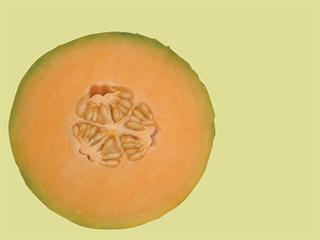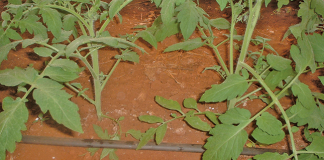
Sandy loam is the ideal soil, but is not essential. More important is that soil pH should be between 6 and 6,5 and there is a balance of available nutrients. Basic fertilisation should be based on a soil analysis to ensure this balance. The soil should also be well-drained. If this is the case, it will not be necessary to plant on raised beds. If planting early, plant on the warm side of a ridge, where the soil is a few degrees warmer.
Melons germinate best at 25°C to 30°C and are not very tolerant of extreme temperatures. Keep this in mind when planting seed directly into the land. Uneven or poor germination will be a waste of expensive seed and produce a lower yield. For this reason, melons are often planted in seedling trays where it’s easier to control the temperature. Rows can be 1,5m to 2m apart depending on the vigour of the variety. In-row spacing is about 25cm to 30cm.
Common Diseases
Melons are susceptible to root diseases and eelworm. This has to be taken into account when choosing a land to plant.
If melons are to follow a crop that is a host to eelworm, examine the roots of this crop to make sure they are clean. If not, take measures to get rid of the eelworm first.
Other diseases include:
- Fusarium wilt – If planting in new ground, you might be able to grow a variety without resistance to Fusarium. But in general, it is always a good idea to select a variety with resistance to the disease. As with watermelons, this is no guarantee that your melons won’t get Fusarium, but it will lessen its impact if the pathogen is present and conditions are favourable for its development. Certain varieties are resistant to races 0,1 and 2. Use long rotations wherever possible to ensure a low population of Fusarium spores in the soil. When planning a rotation, remember that other cucurbits can also host this disease.
- Powdery mildew – Many varieties now have resistance to this disease and it is no longer the hazard it once was. There are also highly effective systemic products available that can be used to control it.
- Downy mildew – As this disease grows in humid conditions, it is not a common problem for melon growers in South Africa. If symptoms appear, use a systemic product. I have not had success with contact fungicides.
- Anthracnose (Rooiroes) – This is another fungal disease that can be problematic, especially in wetter years. Red spots about 1cm in diameter form on the leaves, giving the whole land a reddish colour – hence the Afrikaans name, which means ‘red rust’. There is some resistance in certain melon varieties. Anthracnose was a bigger problem in the past before the advent of effective systemic fungicides. The tolerance of the variety Saticoy to the disease put it on the map in years gone by.
- Alternaria – Another fungal disease, this also manifests as spots of about 1cm in diameter, starting at the leaves nearest the crown. A close examination will also reveal concentric rings. Resistant varieties and suitable fungicides are available.
Defoliation by any of these diseases will result in sunburn, lower yields and a bland eating quality.
Pollination
Keep an eye open to ensure that there are sufficient bees or solitary wasps for pollination. The flowers vary, but usually both male and female flowers have anthers. Because females have anthers, some people assume that melons are self-pollinating. But this is not so, due to the position of the anther above the flower. This flowering pattern is called ‘andromonoecious’. A few varieties are ‘monoecious’ – they have separate male and female flowers with no anthers in the female flower.













